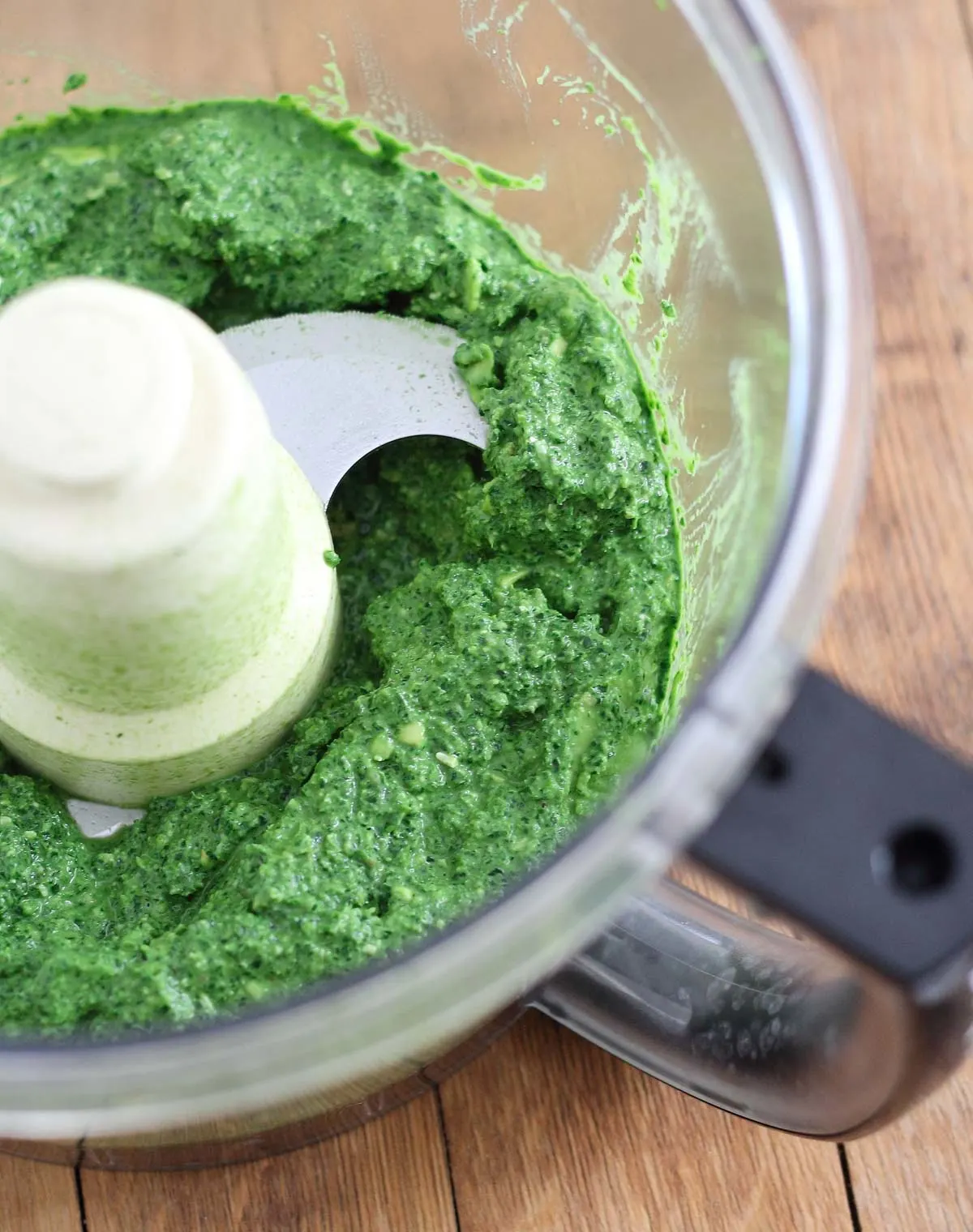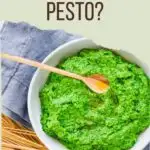As a classic Italian sauce with an abundance of uses, you may wonder if your dog can eat pesto next time you toss it with some pasta or spread it on bread for a sandwich. We’ll dive into the ingredients that make up pesto detailing each one and its potential safety or danger to your pup so you’re armed with the best information.

Is pesto safe for dogs?
Because pesto is a compilation of multiple ingredients, the answer to “can dogs eat pesto?” is not as straightforward as you might think.
From a high level perspective, pesto is not safe for dogs and should be avoided. However, there are a variety of ways to prepare pesto that deviate from the traditional recipe which can make the answer to this question a little more nuanced.
Since dogs can safely eat basil and other herbs like cilantro, you may think pesto is safe for dogs but because it’s traditionally made with garlic, a toxic and potentially fatal ingredient for canines, classically prepared recipes and almost all store-bought varieties are off limits.
If prepared differently though, pesto has the potential to be something that a dog can eat in moderation. Let’s break down the different components to pesto and go through them one by one.
What ingredients in pesto are safe for dogs?
Originating from Northern Italy, classic pesto sauce is compromised of:
- basil
- pine nuts
- extra virgin olive oil
- parmesan and/or pecorino romano cheese
- garlic
- salt & pepper
Basil — By itself, basil is safe for dogs. This herb offers an array of vitamins and minerals as well as antioxidants. It’s often swapped for other leafy greens or herbs to make different types of pesto recipes.
Pine nuts — While high in fat like most nuts, pine nuts by themselves are also safe for dogs to eat. Many pesto recipes swap out different types of nuts like walnuts, almonds, cashews or pistachios. Not all nuts are safe for dogs to eat so be sure to stick to pine nuts if you plan to give pesto to your dog. Some pestos omit nuts altogether and use pumpkin seeds or sunflower seeds instead.
Olive oil — Any high fat food should be given to dogs under careful guidance but extra virgin olive oil is one of the healthiest fats you can offer your dog. High in omega-3s like sardines, good quality olive oil can help improve your dog’s skin and coat while also supporting their immune system.
Cheese — While not considered toxic, cheese is a food that dog owners should minimize in their dog’s diet. It’s another high fat food that also contains lactose potentially disrupting your pup’s stomach, especially if they’re sensitive. There are many pesto recipes now that omit cheese entirely to create a vegan pesto which is a safer option for dogs.
What ingredients in pesto are not safe for dogs?
Garlic — This is the one ingredient in pesto that is not safe for dogs to consume. Garlic contains thiosulfate which is toxic to dogs but not humans. It causes oxidative damage to red blood cells in the dog’s body causing hemolytic anemia. According to studies, while dogs have to consume a very large quantity of garlic (an amount that would far exceed anything in a pesto recipe) to get sick, it’s still best to stay away from this ingredient completely.
If by some chance, your dog ingests an entire jar of pesto or you’ve learned how to grow garlic and they’ve raided the garden or stolen many cloves off the kitchen counter while you’re making a pesto recipe, call your vet immediately.
Some signs of garlic poisoning include lethargy, pale gums, collapse, vomiting, difficulty breathing among others and may take days to show.
Salt — Salt is not outright toxic to dogs like garlic and onions but added salt is not good for them either. Salt levels are another common issue with processed foods and why if you’re going to let your dog eat pesto, it should be homemade where you can control (or best yet, omit) added salt quantities.

How to make a dog-friendly pesto recipe
If you choose to share pesto with your pup, there are some simple tweaks to make the recipe both delicious and safe for him and you.
- omit the garlic entirely
- reduce the amount of cheese
- make sure to use pine nuts or another dog-friendly nut — walnuts, cashews and pistachios are toxic to dogs
- add lemon zest and juice for brightness
- reduce or omit the amount of salt
The important part is that you never use garlic or onions in a pesto recipe. If you otherwise stick to the traditional recipe, pesto can be safe for a dog to eat.
What about other types of pesto?
There are a variety of different types of pesto recipes from red pesto known as pesto rosso made with red peppers or sun dried tomatoes to trapanese pesto made with ripe tomatoes but because each and every pesto is an assemblage of different ingredients, you have to be diligent about reading labels or choosing the ingredients yourself for a homemade version.
So long as there is no garlic, onions or unsafe nuts in the recipe, pesto is typically something you can share with your dog.

The final word on pesto for dogs
Can dogs eat pesto? Yes and no. This is a complicated food and will come down to owner vigilance whether or not it’s safe to feed to your dog. But the bottom line is that pesto is not a necessary food item for your dog or their health. If you’re in doubt, always avoid sharing with your furry friend to ensure their safe and healthy future. If you do choose to share a dog-safe pesto recipe with your pup, keep portions small to avoid excess fat consumption and don’t make it a habit. Pesto is really one of many culinary treats made for humans not dogs.

